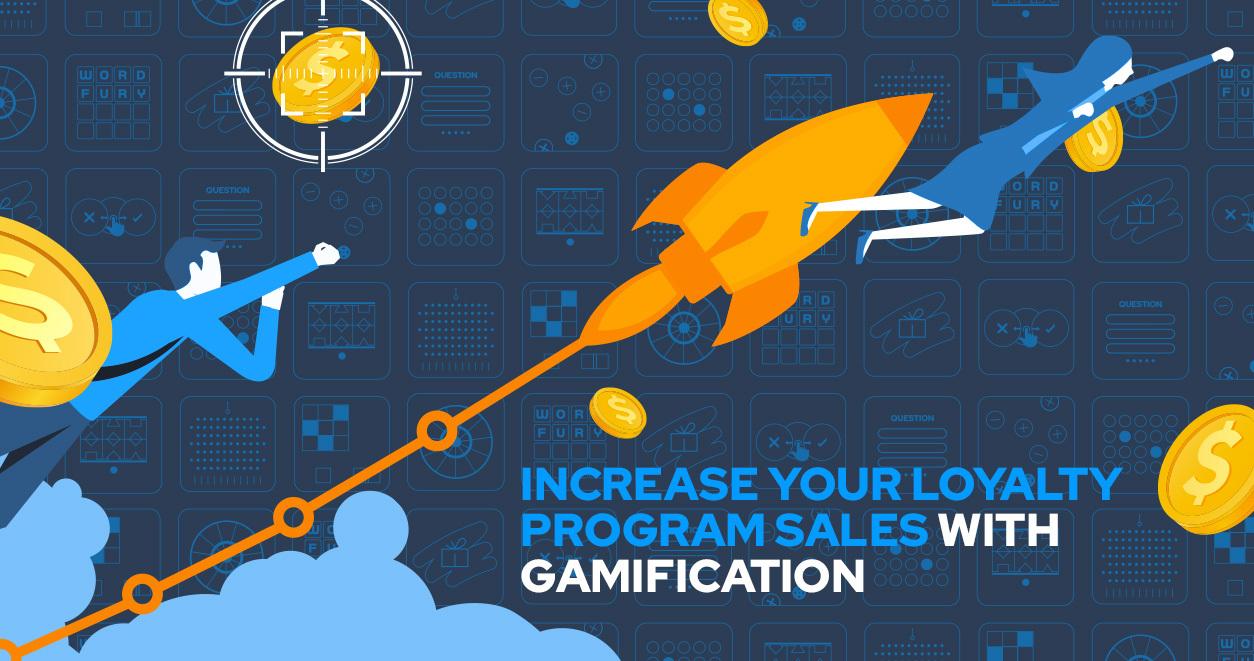In 2025, the CataBoom team executed 755 gamification programs globally for over 75 brands across ten different verticals. We’ve gained incredible data and insights on what is on-trend and effective in driving gamification results. As our team is curating the gamification trends shaping the industry in 2025, we’re happy to share the top 13 gamification trends for the year. Use them to help weave gamification into your marketing plans in 2025!
Gamification Is Growing Fast
Gamification has been on the rise across the globe, helping brands build deeper, non-transactional relationships while engaging customers (and employees). But where is gamification going, and how is it improving?
In 2021, the global gamification market was estimated at $10.5 billion and was projected to reach $96.8 billion by 2030.
Technology and integrations will provide more opportunities for how people interact with gamification strategies as they evolve and are adopted into the mainstream.
1. Gamification Is Transforming Traditional Customer Loyalty Programs
Gamification is a perfect match for building and retaining customer loyalty. Brands can use it as a virtual punch card, rewarding behavior each time a customer purchases. Gamification can also introduce mini-games and competitions into user experiences.
Integrating fun ways for customers to interact with a company helps keep users’ attention while associating a memorable, entertaining experience with the brand.
2. AI Will Integrate More with Gamification
Artificial intelligence (AI) will be the driving force of change in gamification technology. AI offers a predictive element that helps gamification to become more adaptive.
This combination has already been used in the education field with great success. Adaptive educational game programs can now be adjusted according to a person’s skill and education level while sharing knowledge of subjects that might need to be more familiar. This approach leads to a more tailored educational experience.
Due to its transformative impact on so many different industries, the utilization of AI will be one of the more powerful trends in gamification.
3. Personalized Gamification Will Increase in Importance
To cut through the noise of marketing and advertising, personalizing messages and increasing relevance will dramatically capture attention, increasing relevance with an individual customer.
While it’s helpful for companies to integrate gamification into their websites and ad campaigns (among other business aspects), this is much more effective when games are fully customized. Tailoring a game to suit the business and its customers without watermarks from their gamification partners helps build a personal connection with a brand.
A recent study found that most companies use generic gamification ideas to implement their programs. This approach is usually characterized by overemphasizing points, leaderboards, and badges without adding collaboration to the competition. Mordor Intelligence estimates this is the case for 80% of companies that have employed a gamification strategy.
In the future, companies need to reemphasize creating tailored experiences that will help assure a brand “feels” valuable to a customer, thus improving their chances of retaining them.
To that end, CataBoom allows clients to completely brand their campaigns— images, logos, and messaging!
4. Rapid Growth on Social Media Will Increase Users Sharing Gamification Campaigns
As gamification is a highly shareable form of branding and marketing, it’s a perfect fit for social media platforms. With more than 4.26 billion social media users in 2021 (and growth predicted to be six billion by 2027), sharing gamified marketing via a user’s network can turn mindless scrolling into sales.
5. Smartphone Usage Will Continue to Rise
Due to the ever-increasing use of smartphones, your customers have a direct line to your gamification platform via apps and social media. Compound this with the fact that, in 2022, most Americans check their phones an average of 344 times per day—a drastic increase from the already-high 96 times per day in 2019.
Studies show 87% of Gen Zers are likelier to play games on their phones than watch live TV. Whether on mobile devices, consoles, or inside browsers, gaming is increasingly the chosen media entertainment for the new generation. In addition, 83% of millennials and 79% of Generation X also play video games every week or more. Thus, the increased use of smartphones and mobile gaming will continue to be a prime target to capture attention—and leads— with gamified results.
6. Gamification Will Better Motivate Sales Agents
Studies show that gamification can improve sales performance. This approach usually involves your sales team logging their behaviors, resulting in a gamified system with rewards.
Tasks like calling prospects and closing deals can be tied to rewards to encourage and reinforce behaviors and increase positive outcomes. Choose the tasks that make your salespeople better at their jobs and assign value with gamification!
7. AR and VR Tech Will Power Future Gamification Platforms
By bringing digital objects to the real world, augmented reality (AR) is the perfect partner for gamification. One clever example? Pokemon!
As the market size for AR and VR technology is expected to skyrocket to $252.16 billion by 2028, engaging your audience with these immersive experiences is a strategy that is both educational and fun.
Encourage potential customers to come into your store for exclusive savings by finding virtual stickers scattered around your store. Customers can download your app for a virtual scavenger hunt, a subtle way to encourage browsing.
8. Gamification Will Improve the Onboarding of New Hires
On-the-job training for new employees crams in a lot of information in a short window of time. Typically scheduled the same day a new hire starts, this strategy can result in an unstructured mess that rarely teaches anything of value.
The solution? Gamification! By adding it to the onboarding experience, a company can offer the needed structure to improve the process. Studies show you can improve information retention and recall by implementing game design elements. Additionally, you can complete onboarding much faster—some companies find this time reduced by 90%.
9. Gamification Can Motivate Civic Responsibility
Gamification is effective because it provides the proper motivation to improve behavior. One example is Volkswagon’s The Fun Theory, an initiative from Volkswagen that changed people’s behavior for the greater good via this tactic.
Ranging from a sound effect occurring or when people throw their trash into the bin or a staircase into a giant keyboard to encourage walking proves gamification has a place in virtually every sector of industry and life.
10. Gamification Will Break Down Walls in Understanding Healthcare
In the aftermath of COVID-19, telehealth under Medicare increased tenfold, from around 5 million services to over 53 million in 2020. By February 2021, that number rose to FIFTEEN times the pre-pandemic levels.
For the telehealth industry, gamification has already proven to offer many benefits. Current applications include the following:
- Tracking when patients need to take medication
- Educating patients about their chronic conditions
- Tracking calories and blood glucose levels
One successful example is United Health’s Rally mobile app, where users earned points and prizes by eating well, exercising, and having regular checkups. As gamification becomes even more prevalent in the industry, its applications will continue to help patients become better engaged with their daily health and wellness.
11. Gamification Is Making Fitness Fun Again
The fitness industry uses gamification with progress tracking, reinforcement rewards, training, and new ways to play traditional sports. For example, wearable trackers will continue to use this tactic to motivate people to set personal fitness goals.
12. Gamification in the Metaverse Will Grow in Relevance
While the term might be a mystery to some, the metaverse will play a significant role in the growth across multiple industries. And gamification will sit directly at the heart of this new technology.
Considering the AR and VR technologies we mentioned above into account, think of the metaverse as the next generation of online platforms, making it the future of how humans will interact online.
There’s a reason Facebook changed the name of its parent company to Meta. This gamification idea will transform interaction and advertising when users immerse themselves in three-dimensional environments on the platform.
13. Gamification Will Be Used to Create a Pavlovian Effect
Whether to motivate employee changes or move customers towards an upsell, gamification is a powerful way to encourage positive behavior. Companies should target gamification in their communications strategy via consistent, small doses, thus steering their targeted audience towards desired behaviors.
This strategy could include rewards for completing tasks or motivating customers to engage with regular content. Gamification will also increasingly be used to encourage changes in users’ social interactions, purchases, and job performance—even to shape how people engage with important issues of our time.
Plan Your 2025 Gamification Strategy
These trends prove that gamification isn’t a fad—it’s a well-established marketing strategy that delivers outstanding engagement, creates brand love, drives sales, and so much more!
But how do you leverage this strategy to your company’s benefit? Be it for better lead generation or employee engagement, adopting these gamification trends can help you plan your gamification strategy accordingly.
Review your marketing calendar for 2025 and identify the following:
- What opportunities are there to augment your brand’s engagement?
- What sponsorships could you amplify with gamification?
- What 2024 campaigns could you improve?
Research the types of gamification you see integrating with your brand, and activate them!
As CataBoom has helped execute over 6,000 games, our expert team, proprietary gamification, and engagement technology can provide everything you need to apply game elements to any industry or campaign. Get in touch today!








